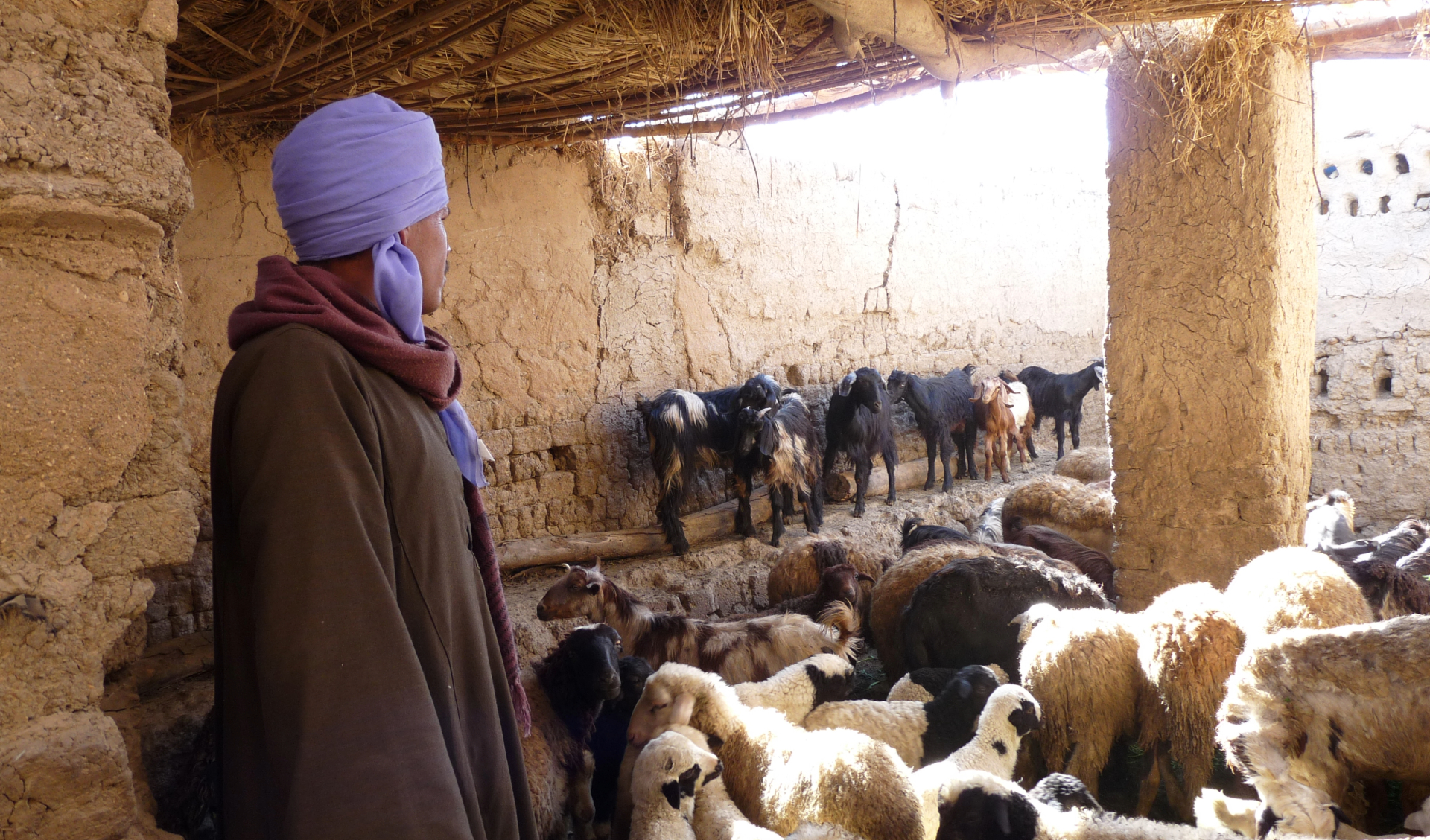Can raising goats for milk be a viable opportunity for small crop-livestock integrated farms in Nile Delta, Egypt?
DOI:
https://doi.org/10.19182/remvt.37569Keywords
Goats, goat milk, farming systems, economic diversification, income generation, EgyptAbstract
Background: Egypt, the third most populous country in Africa, has intense land fragmentation in the Nile Delta, where the size of most farms is under half a hectare. Agriculture, which employs 30% of the population, is facing challenges from water scarcity and declining soil fertility. Large ruminants are harder to maintain due to rising feed costs, worsened by the 2016 devaluation and the ongoing Ukraine-Russia war. Aim: This study explored diversification strategies in small farms in the Nile Delta (Behera governorate), focusing on small ruminants as a potential economic alternative. Methods: The present study analyzed farming systems using the agrarian approach, gathering data through landscape observations and farmer interviews in 2023. A technical-economic analysis evaluated farm performance, and proposed exploring the economic benefits of integrating Egyptian Nubian (Zaraibi) goats. Four breeding scenarios to improve income were assessed, focusing on the type of reproduction and the prices of goat milk. Results: Introducing Egyptian Nubian goats could boost farm income by 28-54%, but high inflation, access to feed, and limited grazing land pose challenges. Conclusions: Improved crop residue utilization, veterinary care, and organized goat breeding are crucial. The goat milk market is currently underdeveloped, and farmers must collaborate to process and market their production effectively. Improved water management and access to credit are also essential for farm sustainability.
Downloads
References
Acloque, D. (2019). Conquérir le désert. Recomposition des acteurs et des territoires agricoles en Egypte. [Thèse de doctorat, Université Paris 10]. These.fr. https://theses.fr/2019PA100143
Alary, V., Corniaux, C., Aboulnaga, A., Galal, S, Radwan, M. A. A., Abdelghany, S., Daburon, A, et al. (2016). Atlas of the traditional milk sector around grater Cairo in Egypt. CIRAD-ARC-APRI. https://agritrop.cirad.fr/584660/
Asfaw, S., Scognamillo, A., Di Caprera, G., Sitko, N., & Ignaciuk, A. (2019). Heterogeneous impact of livelihood diversification on household welfare: Cross-country evidence from Sub-Saharan Africa. World Development, 117, 278–295. DOI: https://doi.org/10.1016/j.worlddev.2019.01.017
Bandyopadhyay, S., & Skoufias, E. (2015). Rainfall variability, occupational choice, and welfare in rural Bangladesh. Review of Economics of the Household, 13, 589–634. DOI: https://doi.org/10.1007/s11150-013-9203-z
Chambre d’agriculture Loire. (2012). Diagnostic Yaourts dans la Loire. Loire. Chambre-agriculture.fr. Consulté le 5 Octobre 2023 sur https://extranetloire.chambres-agriculture.fr/fileadmin/user_upload/Auvergne-Rhone-Alpes/120_Extr-Loire_img/Pages_thematiques/Elevage/doc_diagnostic_YAOURTS_2012.pdf
Cochet, H. (2011). Origine et actualité du «Système Agraire» : retour sur un concept. Revue Tiers Monde, 207, 97–114. DOI: https://doi.org/10.3917/rtm.207.0097
Abou-Elenin, E. I., EL-Hosseiny, H. M., El-Badawy, M. M., Hafez, Y. H., & Teleb, D. F. (2016). Comparing the Effect of Different Feeding Allowances on Performance of Egyptian Zaraibi Goats and their kids. Journal of Animal and Poultry Production, 7(8), 303–312. DOI: https://doi.org/10.21608/jappmu.2016.48718
Ellis, F. (2005). Occupational diversification in developing countries and the implications for agricultural policy. Programme of Advisory and Support Services to DFID (PASS).
Fanchette, S. (1997). Le delta du Nil, densités de population et urbanisation des campagnes. [Thèse de doctorat, Université Paris 8,]. Theses.fr. https://theses.fr/1992PA080720
Ferraton, N., & Touzard, I. (2009). Comprendre l’agriculture familiale. Diagnostic des systèmes de production (1ère édition). Éditions Quae. https://www.quae-open.com/produit/116/9782759203406/comprendre-l-agriculture-familiale DOI: https://doi.org/10.35690/978-2-7592-0340-6
Galal, S., Rasoul, F. A., Anous, M. R., & Shaat, I. (2002). On-station characterisation of small ruminant breeds in Egypt. Technical Report. https://www.researchgate.net/publication/320407634_On-station_characterization_of_small_ruminant_breeds_in_Egypt
Hautbout, L. (2023). Role of the small ruminants in production systems and potential for development of a goat dairy sector: agrarian diagnosis around 2 villages in the governorate of Beheira in the Nile delta, Egypt. [SAADS engineering thesis, option RESAD, Montpellier Agro Institute]. Agritrop. https://agritrop.cirad.fr/608685/1/2023_Resad_Hautbout2_Final.pdf
Le Monde Afrique. (2023). L’inflation en Egypte a atteint près de 40% en août sur 1 an. Le monde.fr. Consulté le 10 Septembre 2023 sur https://www.lemonde.fr/afrique/article/2023/09/10/l-inflation-en-egypte-a-atteint-pres-de-40-en-aout-sur-un-an_6188760_3212.html
Ministry of Agriculture and Food Sovereignty. (2023). Agricultural policies around the world. A few examples: Egypt. Consulté le 20 Octobre 2023 sur https://agriculture.gouv.fr/egypte
Mourad, M. (1993). Reproductive performance of Alpine and Zaraibi goats and growth of their first cross in Egypt. Small Ruminant Research, 12(3), 379–384. DOI: https://doi.org/10.1016/0921-4488(93)90073-Q
Parekh, J. V. (2019, 14–16 August). Applicability of Cooperative Amul Model in African Small Holder Dairying. 15th African Dairy Conference and Exhibition organized by ESADA in Nairobi - Kenya. https://indiandairyassociation.org/uploads/publications/id/ID_V71_No10_Lecture.pdf
Ramadan, R. (2023). Hausse des prix, crise du secteur agricole… les défis du gouvernement égyptien. Fondation FARM. Consulté le 15 Octobre 2023 sur https://fondation-farm.org/prix-crise-agriculture-egypte/
Reardon, T., Berdegue, J., Barrett, B., & Stamoulis, K. (2006). Household income diversification into rural nonfarm activities. In: Haggblade, S., Hazell, P., Reardon, T. (Eds.), Transforming the rural nonfarm economy. Johns Hopkins University Press. http://barrett.dyson.cornell.edu/Papers/IFPRIbookchapter2006Final.pdf
Ruf, T. (1995). Histoire hydraulique et agricole et lutte contre la salinisation dans le delta du Nil. Sécheresse, 6(4), 307–317.
Sharif, M., & Farooq, U. (2004). Study on current and potential market supply and demand, market opportunities and consumer preferences for indigenous breed animals/products. ILRI. https://cgspace.cgiar.org/items/585922de-4f7b-499c-89b9-64e93626715b
Wahel, R. (2018). Le delta du Nil : un ancien front pionnier aujourd’hui fragilisé. Dans Bayoumi, H., Bennafla, K. (dirs.), Atlas de l’Egypte contemporaine (pp.88–89). CNRS Editions. https://books.openedition.org/editionscnrs/37542

Downloads
Additional Files
-
Abstract1302
-
pdf589
-
Matériel supplémentaire / Supplementary Material14
Received
Accepted
Published
How to Cite
Issue
Section
Categories
License
© L.Hautbout et al., hosted by CIRAD 2025

This work is licensed under a Creative Commons Attribution 4.0 International License.
Funding data
-
Agence Nationale de la Recherche
Grant numbers CLAND Program (Climate Change and Land-Management Systems)







